Farming carbon
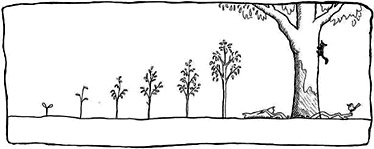
Potential to store carbon
- It is estimated that there are between 50 and 500 tonnes per hectare of living above-ground biomass in eucalypt open-forests.
- The above ground parts of woody plants in eucalypt open-forests can hold about 86 to 860 tonnes of carbon dioxide equivalent per hectare.
- Above-ground carbon in eucalypt open-forests is stored in living trees and shrubs, and also in dead standing trees, fallen timber and litter.
- The estimated living biomass accumulation rate of young regrowing eucalypt open-forest (for example the first 20 years) ranges from 1 to10 tonnes per hectare per year, which equates to between 2 and 17 tonnes of carbon dioxide equivalent per hectare per year.
Carbon farming might not always mean bringing eucalypt open-forests back to their full carbon capacity as soon as possible. Some carbon returns might be traded off against other land uses, such as selective timber harvesting and livestock grazing, which may limit carbon accumulation rates. Selective timber harvesting and low to moderate levels of livestock grazing appear to be compatible with long-term carbon gains in eucalypt open-forests.
Note: to generate carbon credits you will need to register a project with the Clean Energy Regulator using an approved method. The methods detail the conditions or rules for generating carbon credits (Australian Carbon Credit Units) and how vegetation is to be managed as part of a project.
Carbon storage and tree size
Large trees hold far more carbon than small trees because the amount of carbon held increases exponentially as the trunk diameter of a tree increases (see graph). For example, the carbon held in an average very large tree (e.g. 60cm trunk diameter) is about the same as that held in 400 smaller trees (e.g. 5cm trunk diameters) (see graph).
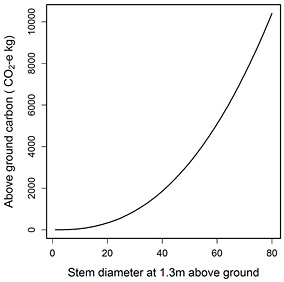

A general relationship between trunk diameter at breast height and above-ground carbon stored in woodland eucalypts (based on Williams et al. 2005, see Eucalypt open-forest Management Guideline (PDF, 2.77MB) for details). Data available for open-forest eucalypts suggests they follow a similar relationship.
| Tree dbh (cm) | Dry matter (kg) | Carbon (kg) | CO2 equivalent (kg) |
|---|---|---|---|
| 5 | 5 | 3 | 10 |
| 30 | 458 | 215 | 790 |
| 60 | 2565 | 1206 | 4424 |
Trade-offs between trees and pasture
Increasing the basal area of trees in grassy woodlands tends to result in decreased pasture yield. This has been observed for a variety of woodland types in Queensland, and the same trend is likely to apply to eucalypt open-forests.
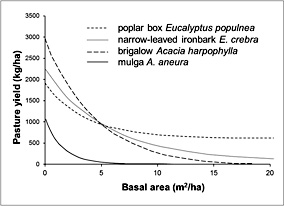

It should be possible to combine carbon farming of regrowth with livestock production, but landholders should consider how increased tree growth may impact on their pasture yield.
Grow big trees to maximise carbon
A few big trees can hold far more carbon than a large number of small or medium trees. So it is in the interests of carbon farming to maximise the height and diameter of existing trees by reducing tree density in dense regrowth. This may involve the selective thinning of smaller trees, or allowing drought and competition among trees to result in natural rates of tree dieback and thinning.
Increasing tree basal area is still likely to reduce pasture yield, but a few large trees will hold far more carbon than many small ones, for the same basal area.
| Tree dbh (cm) | Number of trees | Basal area (m2) | CO2equivalent (kg) | |
|---|---|---|---|---|
| a) | 5 | 1528 | 3 | 14,821 |
| b) | 30 | 42 | 3 | 33,529 |
| c) | 60 | 11 | 3 | 46,940 |
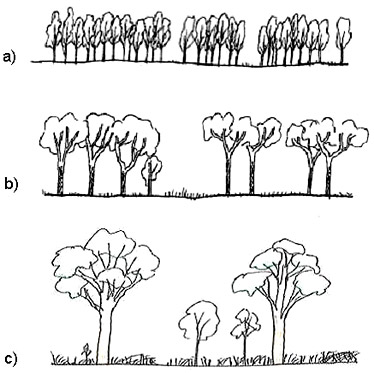
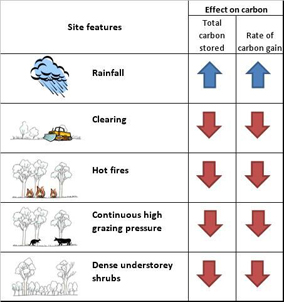

Limits to carbon accumulation
Carbon accumulation in eucalypt open-forest may be limited by rainfall, clearing, hot fires, continuous high grazing pressure and dense understorey shrubs.
The total amount of carbon stored by eucalypt open-forest, and the rate it accumulates, can be maximised by managing these limits where possible.
Rainfall
Variation in rainfall is likely to influence fire regimes, and rates of tree recruitment and growth.
Clearing
Clearing will often reduce the rate of carbon gain, decrease the capacity of the vegetation to store carbon, and produce a net carbon loss.
Careful selective harvesting of trees is still compatible with carbon farming, as this will not damage the health or growth potential of the forest. However, selective harvesting will generally slow the rate of carbon gain, and reduce the amount of carbon stored. Check whether the methodology being used for your carbon project allows thinning or harvest before you act.
Hot fires
Hot fires can damage and kill adult trees, and consume the carbon in trees, shrubs, dead wood and litter. This reduces carbon stores and slows carbon accumulation rates.
Although seedling and adult eucalypts can survive low to moderate severity fires once a lignotuber is formed, the loss and replacement of above-ground parts will slow growth rates. Hot fires should generally be avoided when farming carbon in eucalypt open-forests.
Continuous high grazing pressure
Carbon farming in eucalypt open-forests appears to be compatible with low to moderate levels of grazing pressure that do not suppress the recruitment and growth of eucalypts.
Continuous high grazing pressure is not recommended if it prevents the recruitment of trees or leads to soil degradation. But strategic grazing management that reduces fire risk, and allows tree recruitment is likely to maximise carbon storage and accumulation rates.
More information is needed to determine grazing regimes (including timing and stocking rates) that will allow the optimum production of trees.
Dense understorey shrubs
Whether open-forest eucalypt seedlings survive may be reduced or prevented by high densities of understorey shrubs (such as wattles), and this will slow carbon accumulation rates and may limit carbon stores.


